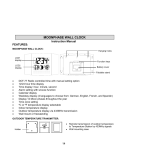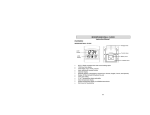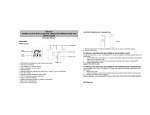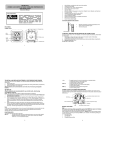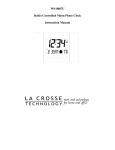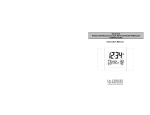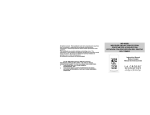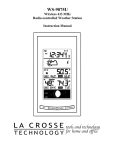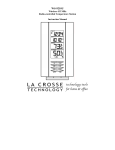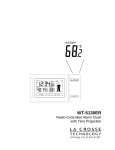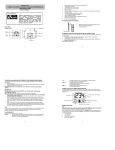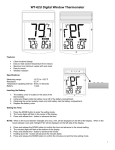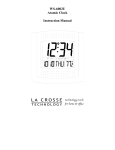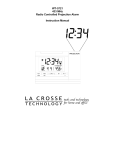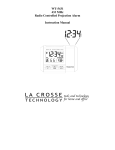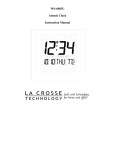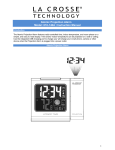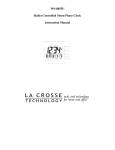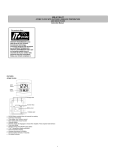Download La Crosse Technology WS-8118U User's Manual
Transcript
RADIO-CONTROLLED CLOCK WITH OUTDOOR WIRELESS
TEMPERATURE
AND MOON PHASE
MODEL WS-8118U
Instruction Manual
TABLE OF CONTENTS
Page
Glossary of Common Terms................................................................................................1
Features................................................................................................................................2
Battery Installation & Change...........................................................................................3-4
Setting-Up.............................................................................................................................4
Function Keys.......................................................................................................................5
LCD Screen Descriptions....................................................................................................5
Moon Phase Symbols..........................................................................................................6
Manual Settings...............................................................................................................6-11
TIME ZONE............................................................................................................................7
DST (DAYLIGHT SAVING TIME) ON/OFF.............................................................................7
LANGUAGE DISPLAY...........................................................................................................8
MANUAL TIME....................................................................................................................8-9
YEAR, MONTH, DATE, AND WEEKDAY...............................................................................9
12/24 HOUR TIME DISPLAY.................................................................................................9
°F OR °C TEMPERATURE...............................................................................................9-10
Changing Display Mode.....................................................................................................10
Alarm Setting and Deactivating....................................................................................10-11
Outdoor Temperature Transmitter...............................................................................11-12
Positioning.....................................................................................................................12-14
Troubleshooting............................................................................................................14-15
Care and Maintenance.......................................................................................................15
Specifications.....................................................................................................................16
Warranty and Contact Information...............................................................................17-19
1
GLOSSARY OF COMMON TERMS
NIST*
The National Institute of Standards and Technology maintains the primary frequency standard for
the United States. The NIST also coordinates the United States time and frequency standards with
other world standards. The NIST provides time and frequency services for United States clientele.
WWVB*
The WWVB is an AM radio station in Ft. Collins, Colorado, managed by the NIST. The WWVB’s
function is to broadcast time-of-day information derived from the NIST atomic clock, located in
Boulder, Colorado.
ATOMIC CLOCK*
An atomic clock is an extremely accurate time device measuring time by the movements of electrons
in cesium atoms. The NIST atomic clock is one of the most precise clocks in the world, accurate to
10 billionths of one second. The NIST’s atomic clock contributes to the international group of clocks
calculating the Coordinated Universal Time (UTC)—the official world time.
RADIO-CONTROLLED TIME*
A radio-controlled time device is often confused with an atomic clock. However, a radio-controlled
time device receives its time information from the atomic clock each day through an internal
antenna. The radio-controlled time device searches for an exact time signal every night when the
signal from the WWVB is the strongest. The signal can be received up to 2,000 miles away through
a radio-controlled time device.
LCD
“LCD” is an acronym for ”Liquid Crystal Display”. This is a common type of display screen used in
televisions, computers, watches, and digital clocks.
CELSIUS (°C)
Celsius is metric system’s unit of measurement used to calculate temperature.
FAHRENHEIT (°F)
Fahrenheit is the common unit of measurement used to calculate temperature in the United States.
*For more information regarding the NIST, WWVB, atomic clock, and radio controlled time, please
visit the NIST official website: http://www.boulder.nist.gov/timefreq/stations/wwvb.htm
1
FEATURES:
RADIO-CONTROLLED CLOCK:
Hanging holes
LCD1
display
LCD2
display
Battery cover
Function
keys
•
•
•
•
•
•
•
•
•
•
•
•
•
Foldable stand
WWVB Radio-controlled time with manual time setting
12/24 hour time display
Time zone setting
Daylight savings time ON/OFF option (DST)
Time display: hour, minute, second
Alarm setting with snooze function
ºC or ºF temperature display selectable
Indoor temperature display
Outdoor temperature display via 433MHz transmission
Calendar display
Weekday display (4 languages to choose from: English, French, Spanish and German)
Current moon phase display
Wall mount or freestanding
OUTDOOR TEMPERATURE TRANSMITTER:
•
•
Battery Cover
Holder
2
Remote transmission of
outdoor MHz signals
Wall mounting case
TO INSTALL AND REPLACE BATTERIES IN THE TEMPERATURE
TRANSMITTER (INSTALL BATTERIES IN TRANSMITTER BEFORE
INSTALLING BATTERIES IN RADIO-CONTROLLED CLOCK)
The transmitter uses 2 x AA,1.5V batteries. To install and replace the batteries, please
follow the steps below:
1.
Remove the battery cover by pushing down towards bottom of transmitter and sliding
cover out.
2.
Insert the batteries, observing the correct polarity (see marking inside battery
compartment).
3.
Replace the battery cover on the unit.
ALKALINE BATTERIES ARE RECOMMENDED FOR USE IN BOTH UNITS. AVOID USING
RECHARGEABLE BATTERIES.
TO INSTALL AND REPLACE BATTERIES IN THE RADIO-CONTROLLED
CLOCK
The radio-controlled clock uses 2 x AA, 1.5V batteries. To install and replace the batteries,
please follow the steps below:
1.
Remove the battery cover.
2.
Insert batteries observing the correct polarity (see marking inside battery
compartment).
3.
Replace compartment cover.
DO NOT SET THE CLOCK.
Note:
In the event of changing batteries of the unit, ensure that the batteries do not spring free
from the contacts. Always wait at least 15 minutes after removing the batteries before
reinserting, otherwise start up and transmission problems may occur.
REPLACEMENT OF BATTERIES
For best performance, batteries should be replaced at least once a year to maintain the best
running accuracy. Ensure that the batteries used are new and the correct size.
Please help in the preservation of the environment and return used
batteries to an authorized depot.
3
WARNING!
•
•
Do not mix old and new batteries.
Do not mix alkaline, standard (carbon-zinc), or rechargeable (nickel cadmium) batteries.
SETTING-UP:
NOTE: Do not set the clock until the outdoor temperature is displayed.
1.
Place batteries in the outdoor transmitter first, then into the radio-controlled
clock.
2.
DO NOT PRESS ANY BUTTONS FOR 15 MINUTES.
3.
After 15 minutes both the Indoor and Outdoor areas on your clock should have a
temperature showing. If not, remove both sets of batteries, wait 15 minutes and repeat
step one.
4.
After the clock receives the outdoor temperature, and 15 minutes have elapsed,
set your time zone. The default time zone is Eastern Standard Time (EST). If you
live in the Eastern Time zone move to step 6.
5.
To set the time zone:
•
Push and release the “SET” function button.
•
The time zone (LCD2) will start flashing (Default setting -5EST).
•
Push the (+) function button to change the default setting (-5EST) to the desired
time zone.
-6 CST (Central Time Zone)
-7 MST (Mountain Time Zone)
-8 PST (Pacific Time Zone)
(See “Time Zone Setting” if you live outside the USA)
6.
After the clock receives the outdoor temperature the WWVB time code reception will
automatically start. The clock will automatically set itself to the exact time, day and
date after receipt of the WWVB time code reception. This typically takes over night.
For best reception place your clock next to a window facing Colorado over night. Once
a successful reception is received the Radio Reception (
) icon will appear above
the blinking colons. Once a successful reception is received relocate your clock to a
desired location. The clock will then automatically attempt to receive the WWVB time
from 12:00 am through 6:00 am each day (attempts WWVB reception every full hour
within this time frame). When this is successful, the received time will override the
manually set time. The date is also updated with the received time (Please refer to
notes on “Manual time setting”).
4
ICON DESCRIPTION
Successful reception of
WWVB time signal
Currently searching for the
WWVB time signal (tower
blinking)
Unsuccessful reception of WWVB
signal. Will work as normal quartz
clock. Will search for the WWVB time
signal overnight.
FUNCTION KEYS
The radio-controlled clock has 4 easy to use keys:
SET key
: To enter into the set mode for the following functions: time zone, DST
ON/OFF (daylight saving time), language, hour, minute, year, month, day,
weekday, 12/24 hour, ºC or ºF temperature display
+ key
: To toggle between the seconds, temperature or weekday display
To change any values in manual set mode
ALM key
: To enter into the alarm set mode
To set the alarm ON/OFF
SNZ key
: To activate the snooze function during alarm
To display the alarm time in normal mode display
To exit the setting modes
LCD SCREEN DESCRIPTIONS
The radio-controlled clock's LCD is divided into 2 sections. When batteries are inserted, all
the segments will light up briefly before displaying the information for time, date, and indoor
Time reception icon
and outdoor temperatures.
Alarm icon
WWVB time
Outdoor temperature display
Indoor temperature
Date
Weekday
5
MOON PHASE SYMBOLS:
The radio-controlled clock automatically calculates and updates the moon phase diagram on
LCD2. The phase display will change approximately every 2 days, 11 hours. Whenever the
date or time is changed manually, the radio-controlled clock will display the updated moon
phase within a few minutes. 12 stages of the moon’s phases are represented.
New Moon
Small Waxing
Crescent
Large Waxing First Quarter
Crescent
FullMoon
Large Waning Small Waning
Gibbous
Gibbous
Last Quarter
Small Waxing
Gibbous
Large Waning
Crescent
Large Waxing
Gibbous
Small Waning
Crescent
Note: The moon phase visible in the sky is noted by a darkening of the LCD screen.
Therfore, a full moon is a complete dark circle.
MANUAL SETTINGS
Note:
If the radio-controlled clock has already successfully received the WWVB time signal
and displays the correct time and date, then the Manual settings can be skipped.
After completion of the above described procedures in “Setting up” the manual setting
modes can be entered by pressing and holding the SET key for 3 seconds. The following
settings can now be programmed:
•
Time zone setting
•
DST ON/OFF
•
Language display setting
•
Manual time setting
•
Year setting
•
Month setting
6
•
•
•
•
Date setting
Weekday setting
12/24 hour time display setting
ºC or ºF temperature setting
TIME ZONE SETTING
After entering the manual setting mode as described above, the time zone can be set using
the number of hours different from Greenwich Mean Time (GMT) range in LCD2. To do this:
1.
2.
The time zone (LCD2) will start flashing (Default setting "-5h“). Select the desired time zone
by pressing and releasing the + key.
Note: The time zones from –4 to –10 hours will be displayed with 3 characters
abbreviations:
• -4 ATL (Atlantic time),
• -5 EST (Eastern time; default time zone),
• -6 CST (Central time),
• -7 MST (Mountain time),
• -8 PST (Pacific time),
• -9 ALA (Alaska time),
• -10 HAW (Hawaii time).
• "GMT” will be displayed if set to GMT (0).
Press and release the SET key to enter the “DST Setting“.
DST SETTING (daylight saving time)
1.
The ON digit will start flashing on LCD1. Set the DST ON or OFF by pressing the +
key.
Press and release the SET key to enter the “Language Setting“.
2.
Note:
The DST default is “ON”, meaning that the WWVB will automatically change the time
according to Daylight Saving Time in the spring and fall. For areas that do not recognize
DST changes (Arizona and parts of Indiana) turn the DST “OFF”.
7
LANGUAGE SETTING
The weekdays can be displayed in LCD2 with the pre-set languages: English, French,
Spanish and German.
US = English
F = French
E = Spanish (Espanol)
D = German (Deutsch)
1.
Set the desired language for the weekday display in LCD 2 by use of the + key.
2.
Press and release the SET key to enter the mode “Manual Time Setting”.
MANUAL TIME SETTING
In case the radio-controlled clock is not able to detect the WWVB-signal (disturbances,
transmitting distance, etc.), the time can be manually set. The clock will then work as a
normal Quartz clock.
Note: In 12 hours mode the time will be displayed with an additional “PM” for the time from
12:00 noon until 11:59 pm.
1.
The hour digits will start flashing on LCD1.
2.
Set the desired hours by pressing and releasing the + key followed by pressing the
SET key.
3.
Now the minute digits will start flashing.
4.
Set the desired minutes by pressing and releasing the + key. If the + key is held, the
units will increase by 5.
5.
Press and release the SET key to move to the “Year Setting”.
Note:
The unit will still try to receive the signal every day despite it being manually set. When it
does receive the signal, it will change the manually set time to the received time. During
reception attempts, the WWVB tower icon will flash. If reception has been unsuccessful,
then the WWVB tower icon will not appear but reception will still be attempted the following
hour.
WWVB time reception takes place from 12:00 am through 6:00 am each day (attempts
WWVB reception every full hour within this time frame). When the time signal is received for
example at 1:00 am, the radio-controlled clock will not attempt to receive the WWVB signal
for the remaining hours until 6:00 am. Therefore, the next signal attempt will take place
8
between 12:00 am and 6:00 am the next day. The other times WWVB reception takes place,
are upon setup and after manual time set exiting mode. Reception is generally not possible
during daylight hours due to the interference of the sun.
YEAR SETTING
The year can be selected sequentially from 2000 to 2049 and will then start over again
(default setting 2000). Only the last 2 digits of the year will be visible on LCD2.
1.
The year digits will start flashing on LCD2. Select the desired year by use of the + key.
2.
Press and release the SET key to switch to the “Month Setting”.
MONTH SETTING
1.
2.
The month digits on LCD2 will start flashing. Set the desired month by use of the +
key.
Press and release the SET key to move to the mode “Date Setting”.
DATE SETTING
1.
2.
The digits for the date will start flashing on LCD2 (Default setting 1). Set the desired
date by use of the + key.
Note: The date can only be set in conjunction with the selected month. For example, it
is not possible to set the date 30 if the month of February is selected.
Press and release the SET key to enter the “Weekday Setting”.
WEEKDAY SETTING
1.
2.
The weekday symbols will be displayed flashing on LCD2 in the pre-set language
section. Set the desired weekday by use of the + key.
Press and release the SET key to enter the mode “12/24 Hours Time Display
Setting”.
12/24 HOURS TIME DISPLAY SETTING
1.
2.
The “12” or “24” will start flashing in LCD1 (Default setting 12h). Select the desired
time display mode by use of the + key.
Press and release the SET key to enter the “ºC/ºF Temperature Setting“.
°C OR °F TEMPERATURE SETTING
9
1.
2.
The characters “°C” or “°F” will start flashing on LCD1 (Default setting °F). By use of
the + key select “°C” for temperature display in degrees Celsius or “°F” for degrees
Fahrenheit.
Press and release the SET key to exit the setting mode and switch back to the normal
display mode.
EXIT THE MANUAL SETTING MODES
•
•
To return to the normal display mode from anywhere in manual setting mode simply
press the SNZ key anytime.
If no keys are pressed for at least 15 seconds in setting mode, the radio-controlled
clock will automatically switch back to normal display mode.
CHANGING THE DISPLAY MODE (DAY, SECONDS, AND TEMPERATURES)
There are 4 possible display modes to view the day, seconds, and temperatures.
The month&date/weekday/indoor temperature/outdoor temperature is the default.
To change the display:
1.
Press the + key. The display should now show the
month&date/weekday/seconds/outdoor temperature.
2.
Press the + key a second time and the display will now show the
month&date/weekday/indoor temperature/seconds.
3.
Press the + key a third time and the display will now show the
month&date/seconds/indoor temperature/outdoor temperature
Press the + key a 4th time and the display will return to the default display.
ALARM SETTING
To enter into the alarm setting mode:
1.
Hold the ALM key for 4 seconds. The hour digits start flashing.
2.
Press and release the + key to set the hour.
3.
Press and release the ALM key to set the minutes. The minute digits start flashing.
4.
Press and release the + key to set the minutes.
5.
Press and release again the ALM key to exit the Alarm setting mode or wait for 15
seconds automatic timeout.
TO DEACTIVATE THE ALARM:
10
Alarm icon
(((•))) (ON)
The alarm will be automatically ON when the alarm time is set. To deactivate the alarm
(OFF), press and release once the ALM key in normal mode display. The alarm icon will
disappear, the alarm is now off.
SNOOZE SETTING
The snooze button can only be used while the alarm is sounding. The snooze period is 10
minutes long. After the 10 minute snooze period, the alarm with sound again.
OUTDOOR TEMPERATURE TRANSMITTER:
The temperature is measured and transmitted to the radio-controlled clock every 1 minute.
The radio-controlled clock will update the temperature display every 5 minutes.
The range of the outdoor temperature transmitter may be affected by the temperature. At
cold temperatures the transmitting distance may be decreased. Please bear this in mind
when positioning the transmitter. Also the batteries may be reduced in power during periods
of extreme cold temperatures.
433MHz RECEPTION CHECK FOR OUTDOOR TEMPERATURE
TRANSMITTER
The radio-controlled clock will receive the temperature data within 15 minutes. If the
temperature data is not received 15 minutes after setting up (the display shows “- - -”), then
please check the following points:
1.
The distance of the radio-controlled clock or outdoor temperature transmitter should be
at least 6 feet away from any interfering sources such as computer monitors or TV
sets.
2.
Avoid placing the receiver onto or in the immediate proximity of metal window frames.
3.
Using other electrical products such as headphones or speakers operating on the
same signal frequency (433MHz) may prevent correct signal transmission and
reception.
4.
Neighbors using electrical devices operating on the 433MHz signal frequency can also
cause interference.
11
Note:
When the 433 MHz signal is received correctly, do not re-open the battery cover of either the
outdoor temperature transmitter or radio-controlled clock, as the batteries may spring free
from the contacts and force a false reset. Should this happen accidentally then reset all units
(see Setting-up above) otherwise transmission problems may occur.
The maximum transmission range is 330 feet from the outdoor temperature transmitter to
the radio-controlled clock (in open space). However, this depends on the surrounding
environment and interference levels. If no reception is possible despite the observation of
these factors, all system units have to be reset (see Setting-up). See our website
www.skyscaninfo.com for more information.
POSITIONING
Before permanently mounting ensure that the radio-controlled clock is able to receive
WWVB signals from the desired location. Also, extreme and sudden changes in temperature
will decrease the accuracy of the radio-controlled clock, and changes in elevation will result
with inaccurate temperatures readings for the next 12 to 24 hours. These changes will
require a 12 to 24 hour wait before obtaining reliable data.
POSITIONING THE RADIO-CONTROLLED CLOCK:
There are 2 possible ways to mount the radio-controlled clock:
•
use of the foldout table stands, or
•
wall mounting
FOLDOUT TABLE STAND
The foldout table stand legs are located on the lower section of the backside of
the radio-controlled clock. Pull the stands out from the bottom center edge,
below the battery compartment. Once the foldout table stands are extended,
place the radio-controlled clock in an appropriate location.
Foldout table stand leg
12
WALL MOUNTING
1)
Using a straightedge, horizontally space at 2.36 inches (60 mm) 3
screw positions on a wall.
2) Install 3 mounting screws (not included) into a wall within
transmission range—leaving approximately 3/16 of an inch (5mm)
extended from the wall.
3) Place the radio-controlled clock onto the screws, using the hanging
holes on the backside. Gently pull the radio-controlled clock down to
lock the screws into place.
Note:
Always ensure that the radio-controlled clock locks onto the screws
before releasing.
POSITIONING THE OUTDOOR TEMPERATURE TRANSMITTER
To achieve a true temperature reading, avoid mounting where direct sunlight can reach the
outdoor temperature transmitter. It is recommended to mount the outdoor temperature
transmitter on a North-facing wall or in any well-shaded area. The maximum transmitting
range is 330 feet obstacles such as walls, concrete, and large metal objects can reduce the
range.
Place both units in their desired location, and wait approximately 15 minutes before
permanently mounting to ensure that there is proper reception. The outdoor temperature
transmitter is not waterproof and should not be placed anywhere it will become submerged
in water or be directly in the rain.
The outdoor temperature transmitter can be mounted in two ways:
•
with the use of screws, or
•
using the adhesive tape.
MOUNTING WITH SCREWS
Remove the mounting bracket from the outdoor temperature
transmitter.
1)
Mounting
Bracket
13
2)
Place the mounting bracket over the desired location. Through the three screw holes
of the bracket, mark the mounting surface with a pencil.
3)
Where marked, start the provided screws into the mounting surface.
4)
Screw mounting bracket onto the mounting surface. Ensure that the screws are flush
with the bracket.
MOUNTING WITH ADHESIVE TAPE
1)
With a nonabrasive solution, clean and dry the back of the
mounting bracket and the mounting surface to ensure a
secure hold. The mounting surface should be smooth and
flat.
2)
Remove the protective strip from one side of the tape.
Adhere the tape to the middle of the backside of the
mounting bracket
3)
Remove the protective strip from the other side of the
tape. Position the outdoor temperature transmitter in the
Mounting Bracket
desired location, ensuring that the radio-controlled clock
can receive the signal.
TROUBLESHOOTING:
Problem:
Solution:
Problem:
Solution:
Problem:
Solution:
Problem:
Solution:
The LCD is faint.
1) Replace the batteries.
No reception of WWVB signal
1) It may help reception to face the front or back of the radio-controlled
clock in the general direction of Ft. Collins, Colorado.
2) Wait overnight for signal.
3) Be sure the radio-controlled clock is at least 6 feet (2 meters) from
any electrical devices, i.e. TV sets, computers, or other radio
controlled clocks.
4) Remove batteries for 15 minutes. See Setting-up.
Hour is incorrect (minute and date are correct).
1) Be sure the correct time zone and daylight saving time are
selected.
"OF.L“ appears in the indoor temperature section of the LCD
1) Move the radio-controlled clock to an area with warmer or cooler
14
Problem:
Solution:
Problem:
Solution:
surrounding temperature. Current surrounding temperatures are
outside measuring range.
"--.-" appears in the outdoor temperature section of the LCD.
1) Remove the batteries of both units for ten minutes, then reinsert
them again. Make sure the batteries are new and fresh. See
setting- up.
2) Move the radio-controlled clock closer to the transmitter or place
the transmitter closer to the radio-controlled clock. Make sure the
clock is at a receivable range from the transmitter.
3) Move the units to another location. Interferences from other
electrical devices operating on the same signal frequency (433MHz)
may prevent correct signal transmission and reception.
"OF.L“ appears in the outdoor temperature section of the LCD.
1) Wait until the current surrounding temperature cools down or
increases. Current temperature is outside of the measuring range of
the transmitter or has temporary affected battery strength. The
outdoor temperature will be displayed again once the current
surrounding temperature is within the range of the transmitter.
CARE AND MAINTENANCE:
• Avoid placing the units in areas prone to vibration and shock as these may cause
damage.
• Avoid areas where the units can be exposed to sudden changes in temperature, i.e.
direct sunlight, extreme cold and wet/moist conditions as these will lead to rapid changes
which reduces the accuracy of readings.
• When cleaning the LCD and casing, use a soft damp cloth only. Do not use solvents or
scouring agents.
• Do not submerge the units into water.
• Immediately remove all low powered batteries to avoid leakage and damage. Replace
only with new batteries of the recommended size.
• Do not make any repairs to the units. Please return it to the original point of purchase.
Opening and tampering with the units may invalidate the warranty.
15
SPECIFICATIONS
Temperature measuring range
Indoor:
+32ºF to +122ºF with 0.2ºF resolution
0ºC to +50ºC with 0.1ºC resolution
("OF.L" displayed if outside this range)
Outdoor :
-21.8ºF to +157.8ºF with 0.2ºF resolution
-29.9ºC to +69.9ºC with 0.1ºC resolution
("OF.L“ displayed if outside this range)
Temperature checking interval
Indoor:
every 10 seconds
Outdoor:
every 5 minutes
Transmission distance
maximum 330 feet in open field, depending upon surrounding
structures, mounting location and possible interfering sources
Power source (alkaline batteries recommended)
Radio-controlled clock :
2 x AA, 1.5V batteries
Transmitter:
2 x AA, 1.5V batteries
Battery life:
about 12 months
Dimensions (L x W x H)
Radio-controlled clock:
Transmitter:
10.03“ x 1.22“ x 9.56“ / 255 x 31 x 243mm
1.57“ x 0.9“ x 5.04“ / 40 x 23 x 128 mm
16
WARRANTY INFORMATION
La Crosse Technology, Ltd provides a 1-year limited warranty on this product against
manufacturing defects in materials and workmanship.
This limited warranty begins on the original date of purchase, is valid only on products
purchased and used in North America and only to the original purchaser of this product. To
receive warranty service, the purchaser must contact La Crosse Technology, Ltd for problem
determination and service procedures. Warranty service can only be performed by a La
Crosse Technology, Ltd authorized service center. The original dated bill of sale must be
presented upon request as proof of purchase to La Crosse Technology, Ltd or La Crosse
Technology, Ltd’s authorized service center.
La Crosse Technology, Ltd will repair or replace this product, at our option and at no charge
as stipulated herein, with new or reconditioned parts or products if found to be defective
during the limited warranty period specified above. All replaced parts and products become
the property of La Crosse Technology, Ltd and must be returned to La Crosse Technology,
Ltd. Replacement parts and products assume the remaining original warranty, or ninety (90)
days, whichever is longer. La Crosse Technology, Ltd will pay all expenses for labor and
materials for all repairs covered by this warranty. If necessary repairs are not covered by
this warranty, or if a product is examined which is not in need or repair, you will be charged
for the repairs or examination. The owner must pay any shipping charges incurred in getting
your La Crosse Technology, Ltd product to a La Crosse Technology, Ltd authorized service
center. La Crosse Technology, Ltd will pay reasonable return shipping charges to the owner
of the product.
Your La Crosse Technology, Ltd warranty covers all defects in material and workmanship
with the following specified exceptions: (1) damage caused by accident, unreasonable use
or neglect (including the lack of reasonable and necessary maintenance); (2) damage
occurring during shipment (claims must be presented to the carrier); (3) damage to, or
deterioration of, any accessory or decorative surface; (4) damage resulting from failure to
17
follow instructions contained in your owner’s manual; (5) damage resulting from the
performance of repairs or alterations by someone other than an authorized La Crosse
Technology, Ltd authorized service center; (6) units used for other than home use (7)
applications and uses that this product was not intended or (8) the products inability to
receive a signal due to any source of interference.. This warranty covers only actual defects
within the product itself, and does not cover the cost of installation or removal from a fixed
installation, normal set-up or adjustments, claims based on misrepresentation by the seller
or performance variations resulting from installation-related circumstances.
LA CROSSE TECHNOLOGY, LTD WILL NOT ASSUME LIABILITY FOR INCIDENTAL,
CONSEQUENTIAL, PUNITIVE, OR OTHER SIMILAR DAMAGES ASSOCIATED WITH THE
OPERATION OR MALFUNCTION OF THIS PRODUCT. THIS PRODUCT IS NOT TO BE
USED FOR MEDICAL PURPOSES OR FOR PUBLIC INFORMATION. THIS PRODUCT IS
NOT A TOY. KEEP OUT OF CHILDREN’S REACH.
This warranty gives you specific legal rights. You may also have other rights specific to your
State. Some States do no allow the exclusion of consequential or incidental damages
therefore the above exclusion of limitation may not apply to you.
For warranty work, technical support, or information contact:
La Crosse Technology, Ltd
2809 Losey Blvd. S.
La Crosse, WI 54601
Phone: 608.782.1610
Fax: 608.796.1020
e-mail:
[email protected]
(warranty work)
[email protected]
(information on other products)
web:
www.lacrossetechnology.com
18
FCC DISCLAIMER
This device complies with part 15 of the FCC rules. Operation is subject to the
following two conditions: (1) this device may not cause harmful interference, and
(2) this device must accept any interference received, including interference that
may cause undesired operation.
Freq. 433.92 MHz
La Crosse Technology
Made in China
WS-8118U
FCC ID: OMO-01RX (Receiver)
OMO-01TX (Transmitter)
082905
All rights reserved. This handbook must not be reproduced in any form, even in excerpts, or
duplicated or processed using electronic, mechanical or chemical procedures without written
permission of the publisher.
This handbook may contain mistakes and printing errors. The information in this handbook is
regularly checked and corrections made in the next issue. We accept no liability for technical
mistakes or printing errors, or their consequences.
All trademarks and patents are acknowledged.
19




















